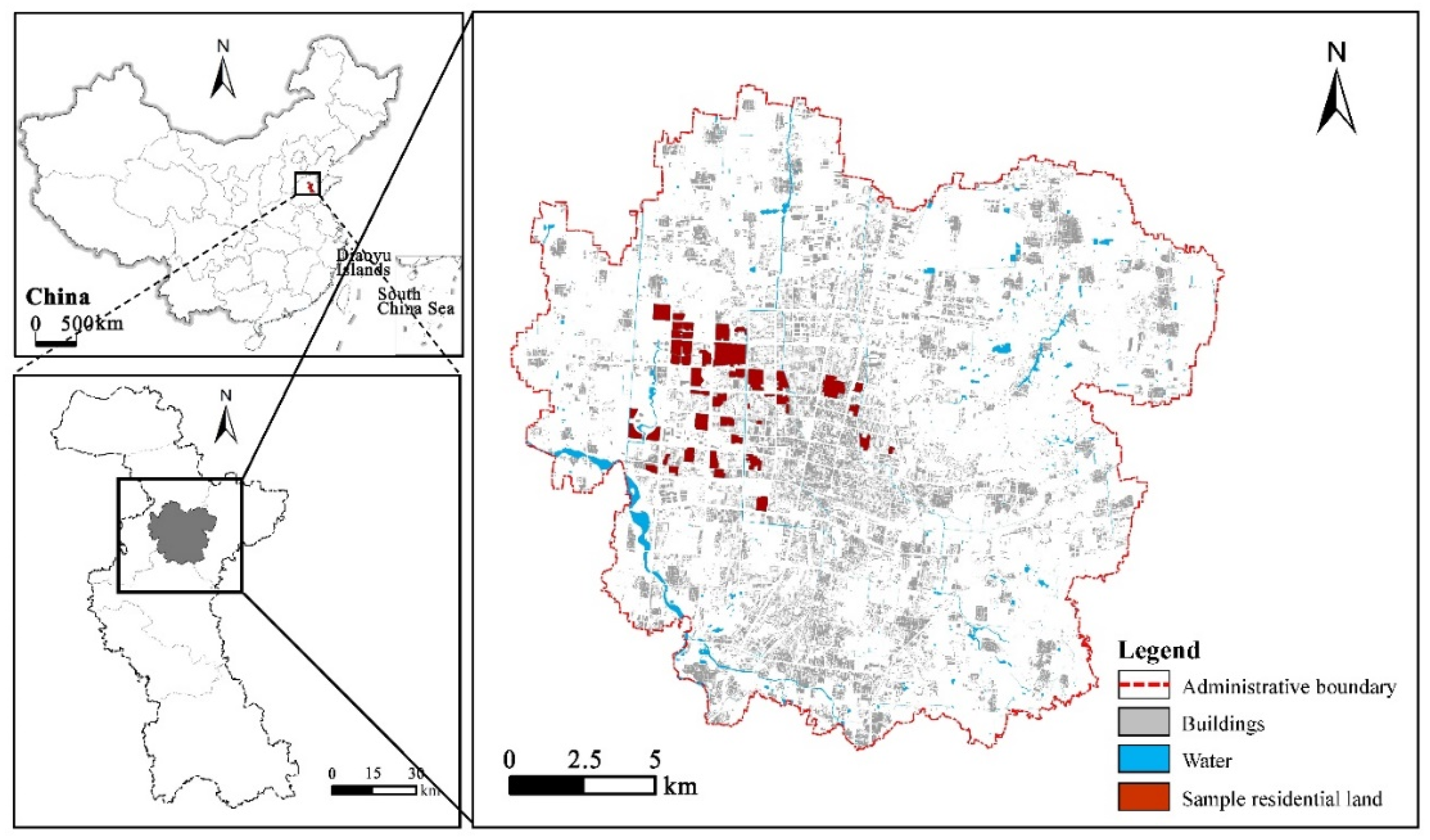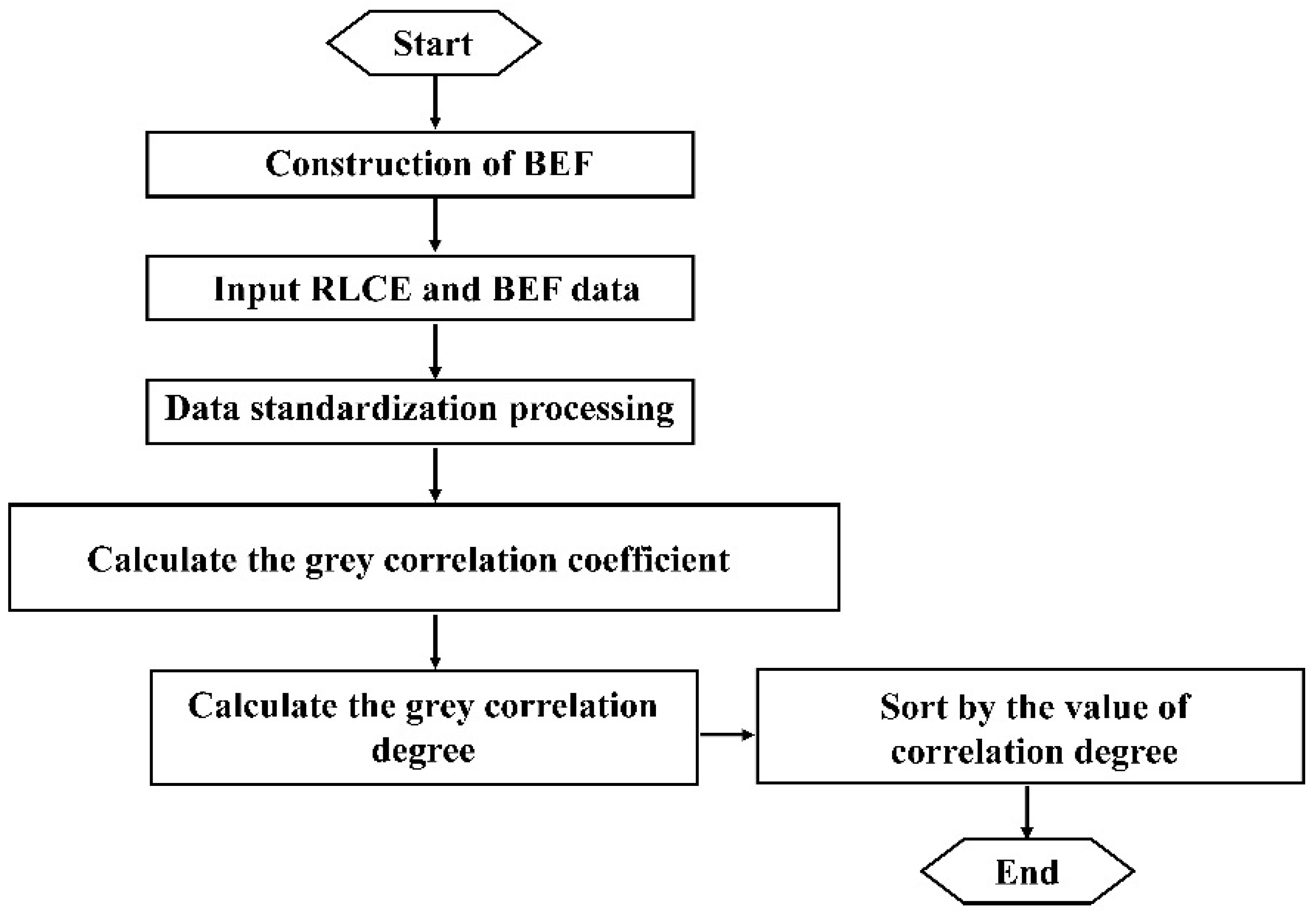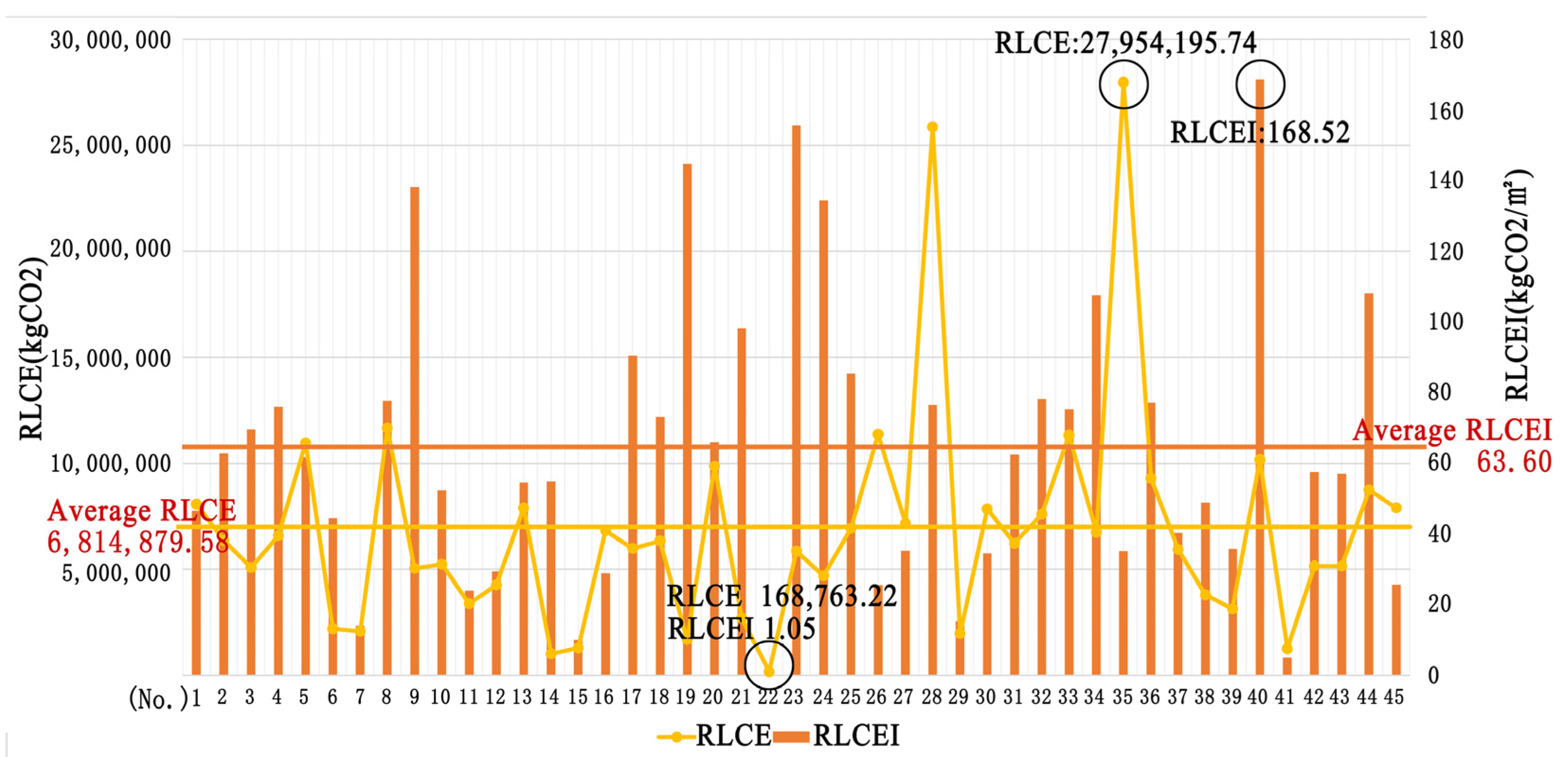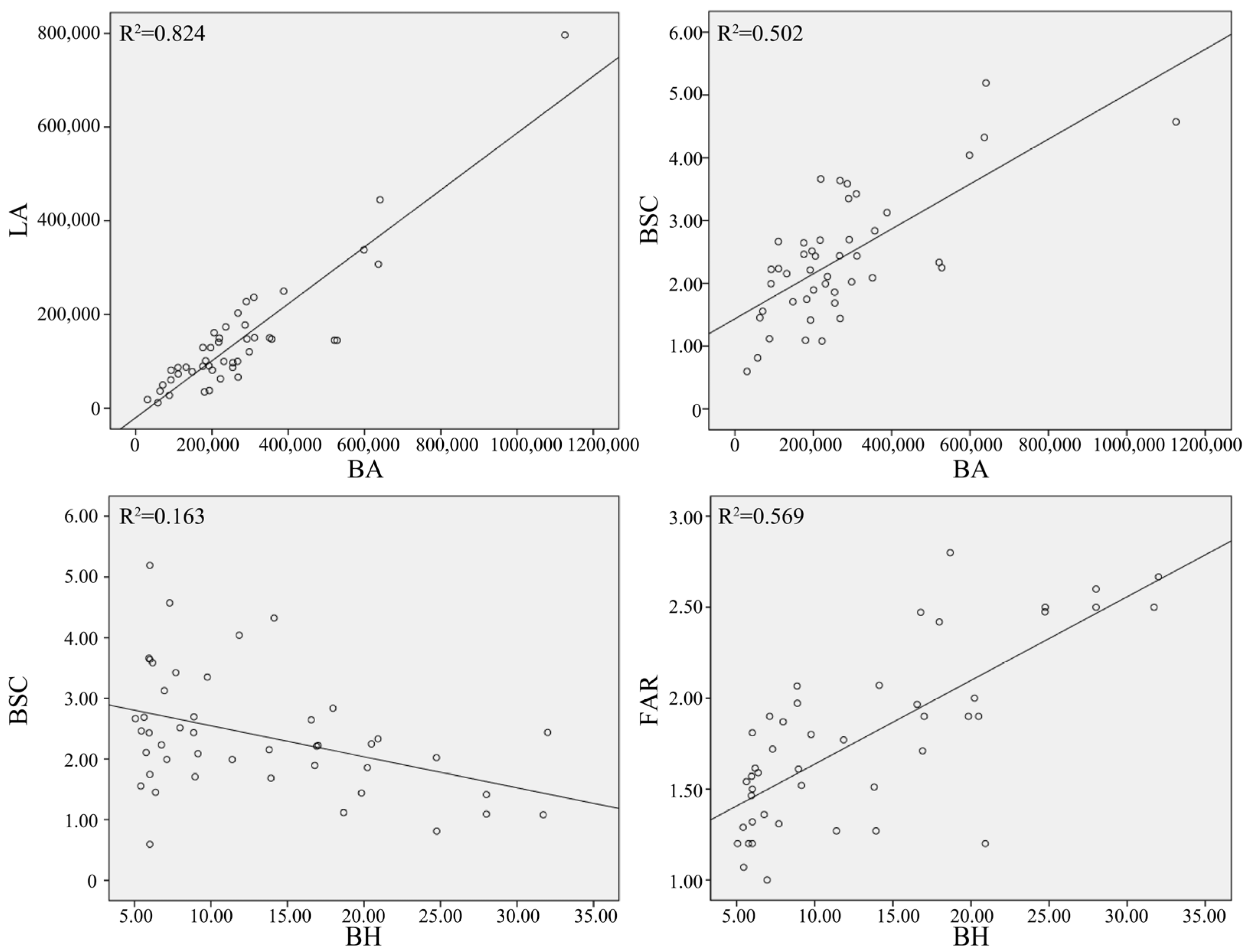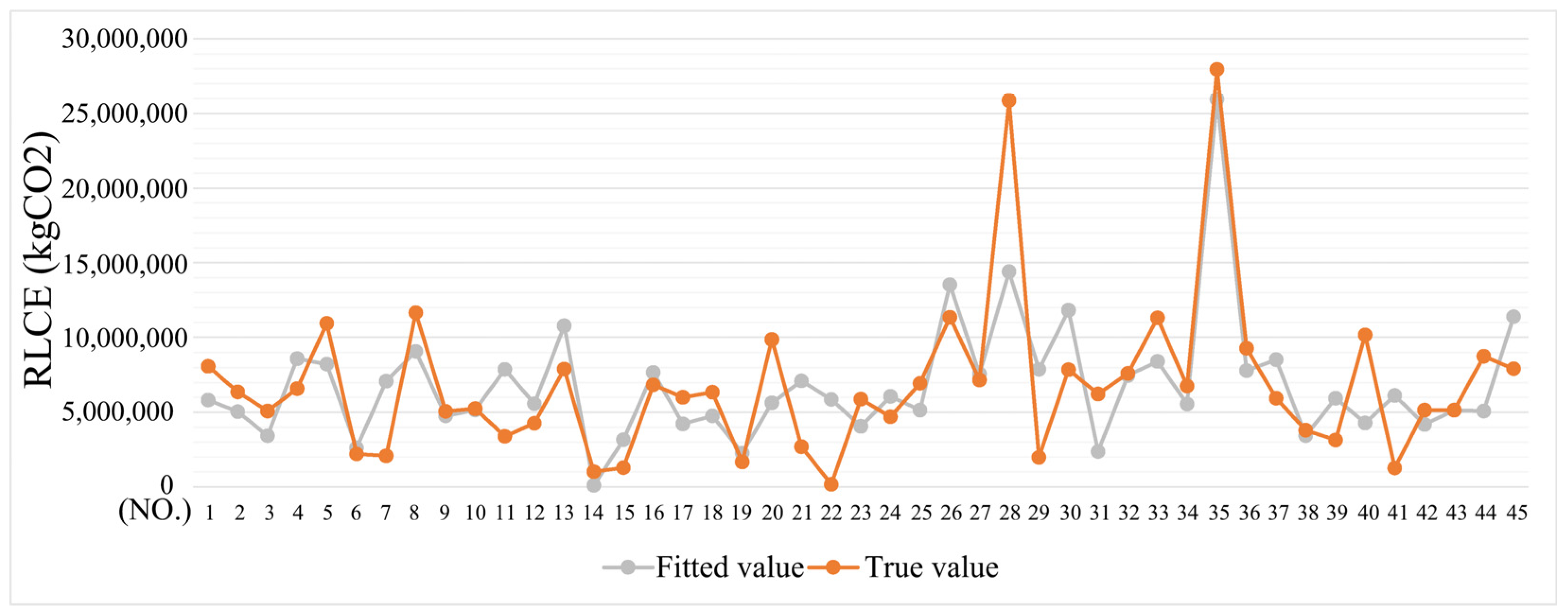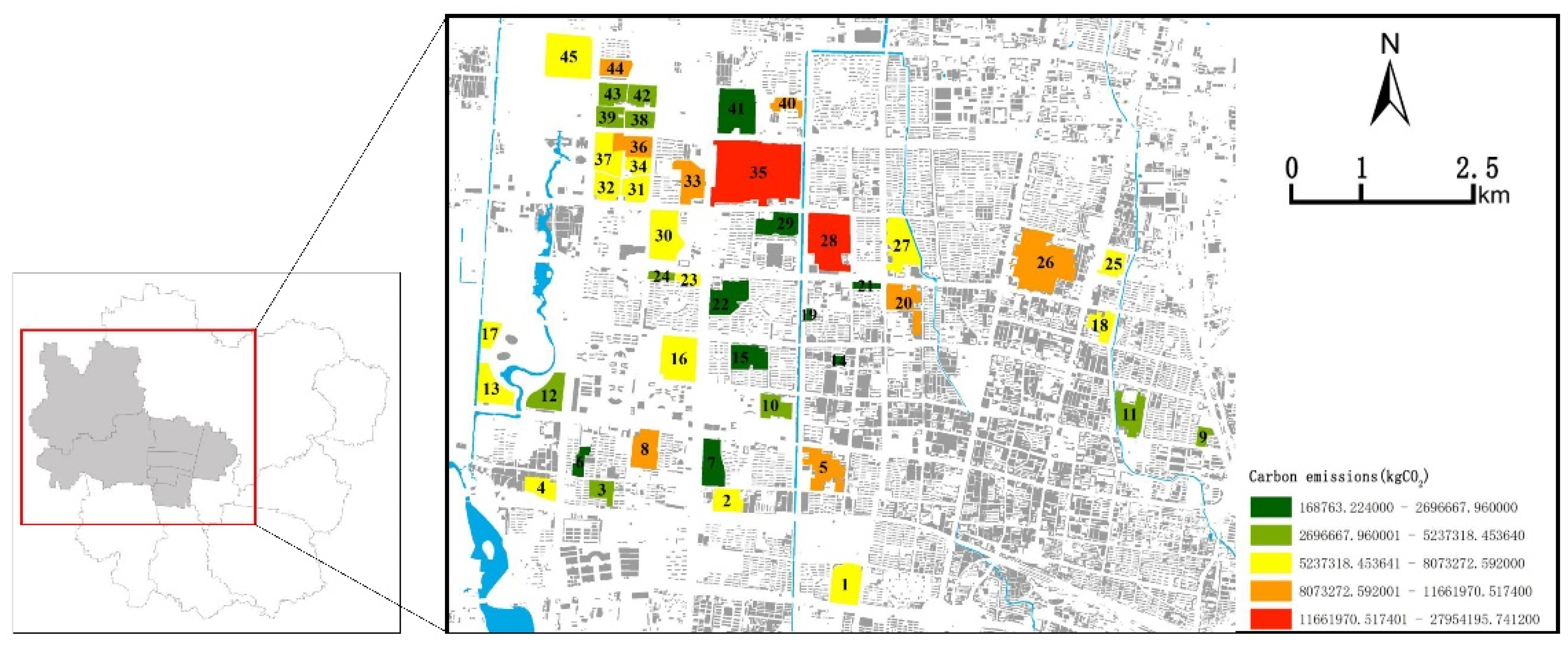1. Introduction
Urban construction land (UCL) is not only the main spatial carrier of human living, entertainment, and industrial production, but also the main carrier of carbon emissions. Although UCL accounts for only 2.4% of the global area, it carries about 80% of the carbon emissions [
1,
2], while in China UCL is responsible for about 73% of the country’s total carbon emissions—and it is still rising [
3]. If nothing is done, climate change will hit the threshold of 1.5 °C in the coming decades, with more serious consequences for the environment, economy, and society to follow [
4,
5]. Therefore, reducing UCL carbon emissions is of great significance to deal with global warming and achieve low-carbon development [
6,
7]. Buildings, industry, and transportation are the three main sources of UCL carbon emissions [
8,
9]. Among them, building energy consumption accounts for about 40% of carbon emissions, while in developed countries such as the United States, building energy consumption has exceeded 60% [
10]. According to the data from the China Energy Statistics Yearbook, the total energy consumption of residential buildings has increased year by year, with an average annual growth rate of 10.12% from 2010 to 2019. Residential land is the most basic unit of residential building energy consumption, and its energy consumption and carbon emissions are closely related to built environment factors (BEF) [
11]. Many studies have illustrated that residential land carbon emissions (RLCE) can be reduced by using clean energy, adjusting the proportion of green buildings, and promoting new energy-saving technologies, but these cannot completely solve carbon emissions caused by BEF such as intensity, density, morphology, and land [
12,
13]. By defining the relationship between BEF and RLCE and carrying out low-carbon optimization, urban planning can achieve the lock-in effect of RLCE. The optimization of BEF can reduce RLCE by 18–24%, and the overall carbon reduction potential can reach 78% [
14]. Therefore, optimization of BEF is an important means to reduce RLCE from the perspective of urban planning.
2. Literature Review
During recent decades, some scholars have made preliminary explorations on BEF that affect RLCE, among which the BEF of building scale and block scale have been widely discussed [
15]. For BEF of building scale, the studies were mainly based on the established statistical database of building energy consumption, combined with the energy consumption simulation method and the analyzed effects of BEF of building scale on RLCE [
15,
16]. For example, Kragh et al. extracted the building area and building age data of 1.60 × 10
6 residential buildings from the Danish National Research Database, then classified the building types and simulated the classified typical building energy consumption. The results show that the error between simulated data and official statistical data was less than 4% [
17]. Streltsov et al. studied the RLCE in Gainesville, Florida and San Diego, California based on the data of utility companies and high-altitude images, and considered that the building shape coefficient and building aspect ratio have more important effects [
18]. Li et al. divided residential building types by building height, building aspect ratio, and building compactness ratio, and simulated the energy consumption of typical buildings. The results show that the error between simulated and true was within 3% [
19]. Luana et al. selected the building construction time, building type, and building scale as the important BEF affecting building energy consumption in Sicily. The energy consumption data for 12 different building types were obtained through energy consumption simulations and compared with the measured data, with an average error of about 7.7% [
20]. Ifigeneia et al. classified the stock of residential buildings in Greece by construction time, building type, building height, and other factors based on data from the Greek Bureau of Statistics and simulated the energy consumption of typical buildings of different types through Energyplus. By comparing with the measured values, the error was between 15 and 18% [
21].
In contrast to the effects of BEF of building scale on RLCE, especially when buildings are arranged in groups, the RLCE is not the sum of single residential buildings’ carbon emissions, and the effects of BEF of block scale should be considered.
For BEF of block scale, the common methods include statistical methods, simulation methods, and comprehensive methods combining statistics and simulation [
22,
23]. For example, Wilson et al. found that BEF such as building density and land area have important and long-term effects on RLCE [
24]. Garbasevschi et al. found significant differences in RLCE by comparing eight residential lands of the same type but with different construction times in Germany [
25]. Wang et al. conducted a correlation analysis between carbon emissions and landscape characteristics of 6754 districts in Eindhoven based on the cluster analysis method and random forest method and found that the function, density, and building floors of different districts have a significant impact on carbon emissions [
26]. Sundus used energy simulation software to analyze the effects of the ratio of high-rise buildings on RLCE and found that when floor area ratio was certain, the ratio of high-rise buildings has a significant effect on RLCE and can reduce carbon emissions by 4.6% [
13]. Kamal et al. evaluated the impacts of the greening rate on urban microclimate and building energy loads by using the open weather data of the Marina district in the city of Lusail and found that the energy consumption of 250 kW h could be reduced with an increase in greening rate [
27]. Leng et al. established the relationship between seven BEF and building energy consumption by using correlation analysis and multiple linear regression analysis. The results indicated that the greater building site cover, floor area ratio, building height, road height–width ratio, total wall surface area, and lower green space ratio were beneficial to the reduction of building energy consumption [
12].
As shown above, the effects of BEF on RLCE have been widely explored. These studies also demonstrate that, from the perspective of urban planning, carbon emissions can be effectively reduced by regulating the range of the BEF. However, due to the different research scales, objects, and problems selected by different studies, there are still some disputes about the effects of some BEF, such as building area, building density, and land area on RLCE, and the impact mechanism is complex. Therefore, the significant correlation and influence relationship between the BEF and RLCE have not yet formed a unified conclusion, and more empirical research needs to be further carried out. Moreover, the relevant studies are mainly based on the questionnaire data or software simulation data, resulting in a certain deviation between the conclusions and the true values.
Fortunately, with the extensive installation and use of the national smart grid and smart sensing equipment, especially the popularization of advanced measurement infrastructure (AMI), power supply companies have obtained a large amount of data with geographical indications and time information. These data record the space-time information of power users in detail, including name, ownership, location, active electric energy, voltage, current, power factor, forward and reverse power, and other power grid status information. Compared with the data of questionnaires and model simulations, which are limited by manual survey costs, survey scale, sample size, and computer simulation performance, AMI data has the characteristics of large amount of data, good compatibility, and high accuracy [
28,
29]. Therefore, studies based on AMI data are gradually increasing, such as user behavior analysis and classification, load prediction, power network planning, distribution network operation status evaluation and early warning, etc. [
30,
31]. However, few studies have used AMI data to investigate the effects of BEF on RLCE.
In response to the current gaps, this study aims to quantitatively analyze the effects of BEF on RLCE based on AMI data and determine which BEF plays the greatest role in reducing RLCE. On the one hand, the empirical study on the effects of BEF on RLCE can be enriched, thus filling in the gaps of existing studies to some extent. On the other hand, it provides recommendations to carry out low-carbon-oriented urban planning in the future.
In the representative resource-based city of Zibo, China, 45 residential lands are selected as research objects. The Grey correlation analysis method and Universal global optimization method are proposed to explore the effects of BEF on RLCE using advanced metering infrastructure (AMI) data provided by the Zibo power supply company. The study starts by emphasizing the significance of the effects of BEF on RLCE. The
Section 2 elaborates on prior research and the knowledge gaps in the literature. The
Section 3 explains the study area, research data, and methods. In the
Section 4, the study presents the results of this study in three subsections: RLCE and BEF, Correlations between BEF and RLCE, and Regression of BEF and RLCE. The
Section 5 further discusses the effects of intensity, density, morphology, and land on RLCE, as well as the perspective of urban planning strategies to reduce RLCE and the detailed applications of the results. The
Section 6 presents the conclusions.
5. Discussion
The Data statistical analysis results demonstrate that different kinds of BEF lead to distinctively different carbon emissions for residential lands in Zibo. However, the mechanism of BEF that affects RLCE according to the quantitative results needs to be explored to provide effective and scientific planning suggestions at the urban design level.
5.1. Effects of Intensity
BA, LA, FAR, and GR are the four main factors to describe the intensity. Among them, the R
2 of LA is 0.557, which is higher than the R
2 of BA, FAR, and GR. Therefore, LA is the primary intensity factor affecting RLCE and is positively correlated with RLCE. The reason for this is due to the increase of LA, which leads to the BA of residential lands also increasing accordingly. As a symbol of urban spatial intensity, BA is usually proportional to it. Generally, residential land with a higher carbon emission combines with a larger LA, higher BA, taller FAR, and lower GR. Additionally, a lower carbon emission residential land is characterized as lower LA with sparse BA, smaller FAR, and larger GR. Although higher BA is an important indicator to measure the economy of land use, it also means higher energy consumption and carbon emissions demand and causes more users, electrical equipment, and lighting to release more heat in a building. Additionally, the high BA also has an impact on the daylighting, thermal radiation, and airflow of the land. High BA can increase the building surface area of the land to absorb solar radiation, thus affecting the microclimate of the land. It can be argued that high BA residential lands alter their thermal environment in the form of raising the ambient temperature relative to that of low BA residential lands, thereby indirectly increasing the energy consumption and carbon emissions. Some studies have also proved this. For example, Garbasevschi et al. found that the RLCE with larger LA in the United States is much higher than those with smaller LA [
25]. Zhang et al. conducted an empirical study on the relationship between RLCE and LA in Nanjing, China by using the ENVI-met simulation data. The results show that in the suburbs with larger LA, the RLCE is higher, while in the central urban areas with smaller LA, the RLCE is lower [
59]. A high GR means there is more green space or open space in the residential land. The green space dominated by deciduous trees has greatly weakened wind resistance in winter, which is equivalent to a square of open space. In addition, the open space as an open and well-connected wind passage provides more heat loss efficiency for buildings through a higher ventilation rate. It is evident from previous studies that a location with a lower green space ratio is warmer compared to a district with a higher GSR in winter [
12]. Therefore, the conclusions also further verify the applicability of the existing research conclusions to the type of resource-based cities.
Additionally, the indicators to measure LA include block scale and road network density. In a certain area, the higher the road network density and the smaller the block scale mean the smaller the LA. Small scale lands can provide a variety of travel options, which can increase pedestrian accessibility and reduce traffic energy consumption carbon emissions.
5.2. Effects of Density
BD and PD are two main factors to describe density. Among them, the R2 of PD is 0.679, which is higher than the R2 of BD. Therefore, PD is the primary density factor affecting RLCE and is positively correlated with RLCE. PD mainly reflects the number of people on the unit land. The effects of PD on RLCE are mainly reflected in the types of energy consumption for different types of buildings, such as lighting, heating, and refrigeration in residential buildings, as well as the energy consumption of lighting, heating, refrigeration, and office equipment in public buildings. The effects occur because there is much more anthropogenic heat generated from heating buildings and other daily human activities in high PD residential lands. When the PD is high, it means that the use intensity of buildings is high and the carbon emissions are correspondingly high. Therefore, it is feasible to reduce RLCE by increasing PD when preparing for low-carbon urban planning.
As an important BEF, PD has a close relationship with other BEF. Based on the definition of PD, Timmons, et al. theoretically deduced the relationship between FAR, LA, and BA [
42]. That is, PD is the product of the proportion of residential land, population per unit building area, and FAR of residential land. In addition, it has been further proved that the increase of PD can promote the increase of urban heat island intensity and the expansion of its scope, and further affect the RLCE [
60]. In general, PD is positively correlated with BA and urban heat islands but negatively correlated with housing areas. The higher the PD, the greater the BA and heat island effect, the smaller the housing area, and, therefore, the RLCE increases significantly.
5.3. Effects of Morphology
The effect of morphology on RLCE is greater than that of intensity, density, and land. The results show that the R2 of BSC, HRBR, and BH are significantly higher than that of other BEF, especially intensity, which is different from other studies. The study holds that in resource-based cities such as Zibo, the intensity of residential lands is homogeneous to a certain extent and the difference in RLCE is more reflected in the difference in morphology. Therefore, compared with the optimization of BEF, which focuses on intensity in big cities, the optimization of BEF should pay more attention to morphology in the reduction of RLCE in resource-based cities.
Among morphology, BSC and BH are positively correlated with RLCE. BSC refers to the ratio of building surface area to volume. Under the same conditions, the larger the BSC, the larger the surface area of heat exchange between the unit volume building and the atmosphere, and the more heat gain or heat dissipation per unit volume through the unit surface area. On the contrary, the smaller the BSC, the less heat gain or heat dissipation per unit volume through the unit surface area, which is an important aspect affecting RLCE.
BH can change the microclimate environment around the residential lands by affecting the sunshine conditions, temperature, and wind environment. The microclimate environment is an important factor affecting building energy consumption, such as building heating and cooling, which significantly increases RLCE. Some studies have also proved this. For example, Zoulia et al. compared the air temperature data of 30 meteorological stations in Athens and found that the urban heat island caused the temperature in the urban area to rise by 10 °C. Accordingly, the energy consumption of urban buildings in summer doubled that in the suburbs [
61]. Waldron et al. used virvil plugin software to conduct a simulation analysis and perform comparative research on the effects of BH on building energy consumption. The results show that the energy consumption per unit building area of high-rise, middle-rise, and low-rise buildings increases in turn, but the total building energy consumption and carbon emissions decrease in turn [
62]. The reason is that the increase in BH will lead to a corresponding increase in BA and PD, and then an increase in RLCE. Additionally, BH can also affect building energy consumption in two other ways. (1) By affecting the change of air temperature, the building energy consumption in the process of heat and moisture transfer is affected. (2) By affecting the indoor and outdoor air exchange of the building, which causes the heat balance of the house to be affected. HRBR and RLCE show a changing relationship of first decreasing and then increasing.
5.4. Effects of Land
The impact of land on RLCE in resource-based cities such as Zibo is less than that in big cities. In some studies, the land is an important BEF affecting RLCE. However, in our study, except for the high R
2 of ILR, the R
2 of LCT, CLR, CSLR, TLR, ALR, and GLR are 0.075, 0.383, 0.371, 0.324, 0.399, and 0.416. The results show that, in terms of reducing RLCE, the carbon reduction benefit of land optimization within 500 m around residential lands in resource-based cities is less than that of the other three types of BEF. Zibo is a representative resource-based city, with a high ILR and scattered distribution, which makes this factor special. As is shown in
Figure 4, ILR is positively correlated with RLCE, which means that in residential lands with high ILR, RLCE is high. The reason for this is that the more industrial land around residential lands, the more employment opportunities. Therefore, more residents choose to work nearby and spend more time at home. Although the choice of low-carbon commuter transportation can be increased, it will also increase the carbon emissions of residents’ electricity consumption to a certain extent.
5.5. Applications
In recent years, how to accurately analyze the effects of BEF on RLCE has been a great concern [
63]. The results obtained in this study can be used to supplement and improve the control index system of the existing urban planning at the medium and micro scales. This is of great significance for guiding policymakers to formulate targeted emission reduction policies or helping urban planners to formulate low-carbon urban planning schemes that are more targeted to control RLCE. The detailed applications are shown in the following two aspects.
For one thing, the measurement methods of RLCE and BEF were proposed in this study and a database was established to provide the carbon emissions of each residential land with a clear geographical location and boundary, which can identify the key carbon reduction regions and provide more accurate information for the local government’s carbon emission control and management (
Figure 8). This is also very essential for low-carbon urban planning as the database also provides sufficient data for our further study of the relationship between RLCE and the BEF and allows for the visualization of how and why existing residential lands affect carbon emissions due to their intensity, density, morphology, and land, which can be additional support for urban planning to achieve carbon reduction.
Another thing is to further illustrate the applicability of the analysis results, which can be used to reduce the carbon emissions of the urban planning schemes. According to the results of RLCE and BEF in
Section 4.2 and
Section 4.3, the specific low-carbon optimization methods for the BEF on RLCE in the urban planning scheme can further be proposed. Then, by predicting the urban planning scheme after optimization again—and comparing it with the carbon emissions prediction results of the urban planning scheme before optimization—the carbon reduction benefits of low-carbon optimization of urban planning schemes on RLCE can be evaluated. Taking residential land 6 in the urban planning scheme as an example to illustrate in detail (
Figure 9), the carbon emissions of residential land 6 before optimization was 1.1660 × 10
4 tCO
2 and the carbon emissions of residential lands 6-1, 6-2, 6-3, and 6-4 after optimization were 8.8700 × 10
3 tCO
2, which was a reduction of 2.7900 × 10
3 tCO
2 and accounted for 23.93% of the carbon emissions of residential land 6 before optimization.
5.6. Limitations and Further Improvements
There are also some uncertainties in this study. Firstly, although the research methods we proposed provide a new possibility to explore the effects of BEF on RLCE under the condition of limited statistical samples, there are only 45 residential land samples, which will affect the accuracy of the results. Secondly, compared with other studies, the RLCE is represented by electricity consumption carbon emissions in this study, without considering the gas, transportation, and waste transfer. Although it is feasible, it will also have errors. Thirdly, the time series of building energy consumption data needs to be extended. The robustness of the results of this study can be improved by analyzing changes in panel data over many years. Finally, the optimal BEF could be further studied to reduce the RLCE.
6. Conclusions
In this study, we quantitatively investigated the effects of BEF on RLCE using advanced metering infrastructure (AMI) data in Zibo, a representative resource-based city in China. Forty-five residential lands and the corresponding building energy consumption data, as well as 16 BEF surrounding these residential lands, were studied in detail through a combination approach of the Grey correlation analysis method and the Universal global optimization method. Some conclusions can be obtained as follows.
BEF have remarkable effects on RLCE. Among them, the correlation coefficients between BA, BSC, GA, LA, FAR, BD, and RLCE are 0.9713, 0.9672, 0.9663, 0.9645, 0.9621, and 0.9611; the correlation coefficients between CLR, LCT, BH, PD, CSLR, GLR, TLR, HRBR, ALR, and RLCE are 0.9523, 0.9520, 0.9500, 0.9491, 0.9410, 0.9355, 0.9301, 0.9290, and 0.9220; and the correlation coefficient between ILR and RLCE is 0.9175.
BEF are satisfactorily and nonlinearly related to RLCE, and the value of correlation coefficient R is 0.788, while R2 is 0.606. Among BEF, the R2 of BSC, HRBR, BH, PD, and ILR are 0.754, 0.699, 0.684, 0.679, and 0.634, and are the key BEF. The R2 of LA, BA, FAR, and GLR are 0.557, 0.548, 0.429, and 0.416, and are the secondary influencing BEF. The R2 of LCT is 0.075 and has the least effect on RLCE.
LA is the primary intensity factor affecting RLCE and is positively correlated with RLCE. PD is the primary density factor affecting RLCE and is positively correlated with RLCE. The effects of morphology on RLCE are greater than that of intensity, density, and land. Among morphology, BSC and BH are positively correlated with RLCE, while HRBR and RLCE show a changed relationship of first decreasing and then increasing. The effects of land on RLCE in resource-based cities such as Zibo are less than that in big cities.
For this study, after obtaining the analysis results above, the possible urban planning strategies in residential land can be proposed for carbon emissions reduction. By optimizing the density, function, form, and land, such as reducing LA, PD, BSC, BH, and increasing HRBR within a certain range, urban planning can ultimately achieve the effects of carbon emissions reduction. The results obtained in this study can be used to supplement and improve the control index system of the existing urban planning at the medium and micro scales, which can provide valuable guidance for emission reduction policies and low-carbon planning. Moreover, the results provide a basis for establishing the prediction method of RLCE and putting forward suggestions for the low-carbon optimization of BEF and can be used to predict and reduce the carbon emissions of urban planning schemes. Overall, it was discussed that the onus is on a group of people, including designers, urban planners, policymakers, and building managers, to take measures to put forward energy-saving-oriented urban planning strategies and ensure their implementation, which is of great significance to mitigate climate change and develop low-carbon cities.
